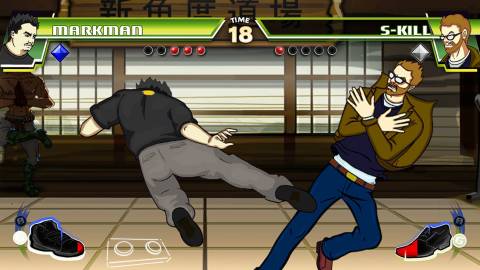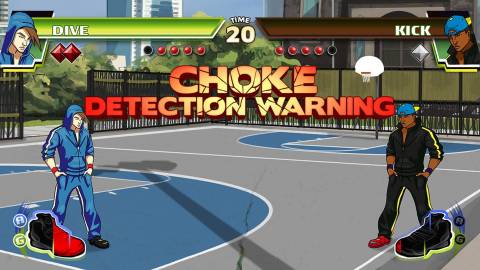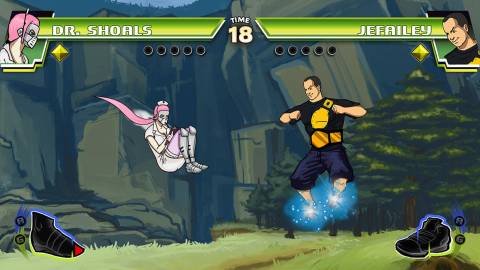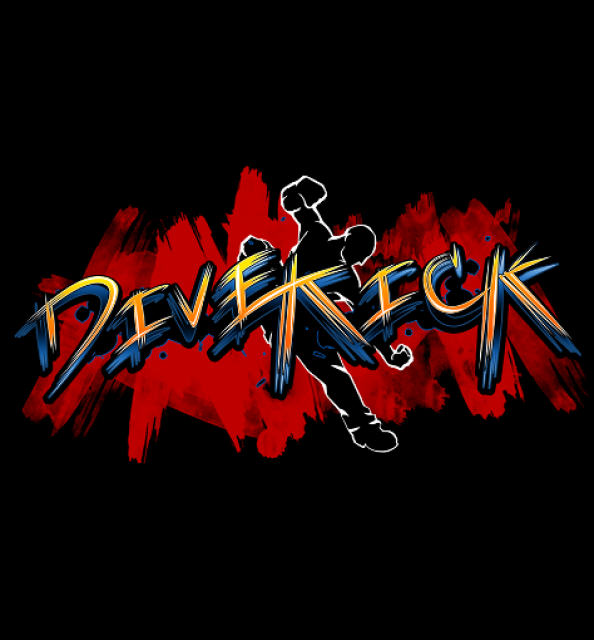It may not be as instantly accessible as originally intended but Divekick is still brilliant fun for all
It’s all about that one moment. Everyone who’s ever played or watched a fighting game knows it. It’s the final round, both players have a slither of health left and the next move is pivotal; the difference between success and failure, win or lose. Whether it’s playing against a friend, competing in an online ranked match or watching one of the many tournament streams of the fighting game community, everyone knows that one moment. It’s the veritable height of tension, excitement, elation and anguish.Divekick is that one moment distilled into an entire game. Each round of every single fight captures the thrill of those final few seconds in a tightly-contested bout; the moment that entices newcomers to the genre and sends diehard fans into mass hysteria. And it’s all accomplished with only two buttons.

What started out as a simple concept featuring two near-mechanically identical characters and a staple move of 2D fighting games, has now evolved to feature a roster of thirteen that surprises with its hidden depth. It’s odd to say that a game with only two buttons has any intricacy, but therein lies Divekick’s beauty. With one button to jump and one to kick it’s easily accessible for newcomers to the genre. Rounds are a quick twenty seconds (and they rarely ever last that long) and each fight’s nine possible rounds will end after one single hit (the health bars are just for show). It’s the fighting game condensed to its purest form, sans any barrier to entry and welcoming to those dumbfounded and put off by the commitment required to learn the inner workings of the genres best. It’s a test of reads and reactions, of tactically positioning yourself based on your character’s idiosyncrasies and those of your opponent.
At its most elementary you simply jump and divekick, launching through the air to knock your opponent down in their stride. The characters of Dive and Kick showcase this concept at its base level, adopting the roles of Ken and Ryu (even if they are parodies of Yun and Yang) in Divekick’s outlandish universe with the most easy-to-grasp attacks. Positioning is determined by how high you jump and the angle of your kick. Press the kick button when your feet are on the ground and you hop backwards; kick enough and your super meter fills, how you use it depends on your fighter selection. These are simple systems and mechanics that welcome the uninitiated, removing the need to mesmerise button combos. Anyone can pick up Divekick and immediately start having fun, and it’s certainly at its best when played with friends, either locally or online.

However, there is an ever present complexity underpinning this apparent simplicity. Venture away from Dive and Kick and you’ll encounter characters with variations on the simple divekick. The Baz, for example, doesn’t defeat his opponents with his kick but with a trail of lightning that follows it. He can also pause mid-air and alter the angle of his kick, making him very effective if you can adjust to the peculiar way he deals damage. Other characters, like Jefailey, change from round to round. With each win his head begins to grow as his ego inflates, allowing you to jump higher while subsequently increasing the likelihood of suffering a critical headshot that leaves you concussed in the next round, drastically reducing the height of your jumps and the speed of your kicks. Dr Shoals, on the other hand, can perform a trajectory altering kick during her initial attack.
Each of Divekick’s thirteen characters adopt their own unique move lists, terrifically setting them apart from one another. That philosophy continues as you begin to experiment with each fighter’s singular special moves. As you build up the super meter via kicking you can either exert it by using Kick Factor (a parody of Marvel vs Capcom 3’s X-Factor that speeds up your character for a limited time) or by using your special moves. Each character has a ground move and an air move that can be activated by pressing both buttons at once provided you have enough meter. These range from the ability to temporarily float in the air to avoid dangerous situations or to set-up divekicks of your own, to a shoryuken-style Upkick and a handy duck. Though each character shares the same two buttons it quickly becomes apparent how diverse they each are, drawing an improbable amount of depth out of its simple control scheme.

Of course, this welcome complexity does contradict the notion that Divekick is incredibly easy to pick-up-and-play for newcomers to the fighting genre. There’s certainly an amount of explanation required whenever someone new picks a different character and wants to learn their many quirks, but Divekick handily subsides this somewhat with a story mode for each fighter. The AI is a tad on the easy side but these fights offer up a way to learn each character’s move list whilst unearthing their back stories via a handful of short motion comics. It’s a lacklustre mode - and the only single-player content available - but it serves its purpose, offering a chance to practise with a character before taking them online (even if tutorials or a training mode would have proven more useful).
Once you begin to play competitively against other people Divekick’s appeal is at its most discernible. Whether you’re playing locally with friends for a laugh or displaying your high-level skills in a ranked match, Divekick’s mechanics and use of basic fighting game concepts translate well to any environment. Some may write it off because of its simplistic control scheme and visual style but they would be missing the point. It may have slightly deviated from its original design to welcome the uninitiated to the genre – the many, many knowing references reveal a game that’s meant for the fighting game community more than anyone else – but the added depth proves welcome, even if it requires a little more understanding. Divekick is still all about that one moment, there’s just a little more nuance along the way.
